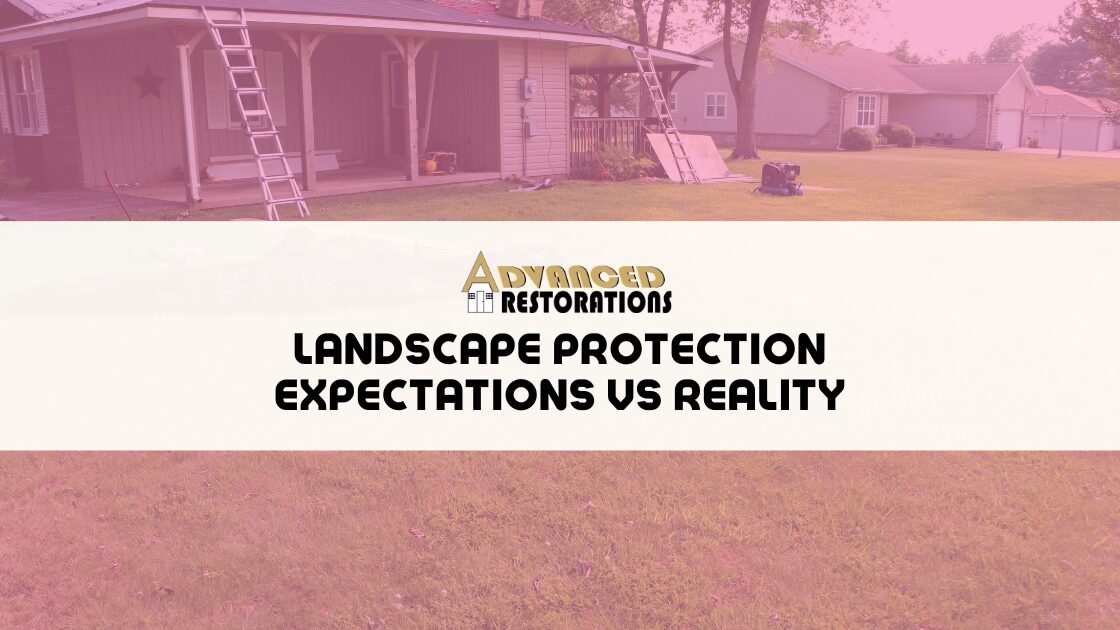
Landscape Protection – Expectations Vs. Reality
Advanced Restorations has had the pleasure of completing projects for homeowners that owned immaculate properties. We’ve seen amazing landscaping, beautiful architecture, and breathtaking views. On the other hand, we’ve also completed projects for homeowners that were, without being too unkind, a bit behind on their upkeep. But all those homeowners had the same thing in common, they wanted to be sure their properties were not left a mess by the time their project was completed.
While we plan to do our best effort to leave the property as it was when the project is completed, we do need to be sure that we are realistic on what those efforts and results will look like. Many things need to be considered during this process – is there access for a roofing crew to have their dump-trailer in an advantageous area to collect roofing debris? Is the roofing system simple enough to allow the roofing crew to move debris from one side of the roof to the other? If you’re living in a two-story home with a twelve-pitch roof, we’ll need to accept that materials will be dropped to the ground prior to being hauled to the trailer – it would not be feasible (or safe) for the crew to haul those materials across the roofing system to facilitate a more orderly clean-up. Is it a single-story home with a low pitch roofing system? This will more easily allow the crew to bring materials to a specific are for dropping directly into their trailer.
There are options available for both roofing contractors and homeowners that want to be sure their property is protected when materials cannot be directly deposited to the dump trailer – the use of which is scenario-dependent. If the property is lacking any major plant life directly around the home, tarps will typically be used to catch debris, making it easier to be haul those items away after project completion. If there is extensive landscaping involving flowers and shrubbery, the use of a more extensive system like the Catch-All would be called for.
The Catch-All is a series of nets and mesh tarps that are temporarily installed around a home, providing a barrier and pathway for debris to fall, and be collected. This, in coordination with strategically placed sheathing (propped to protect windows and other fragile items), will provide enough protection to keep any major issues at bay.
If we begin a project and the expectation is that each individual piece of debris will be placed neatly in a dumpster or trailer, one at a time, that may not be the most realistic or feasible expectation to have. But rest assured, the crews are meticulous with their clean-up. After the tarps have been moved away, magnets are run along the same areas to collect stray nails and bits of metal that may be mixed in. Many crews also employ runners (new employees that are strictly handling physical labor items) that work on clean-up during the process, policing stray bits of debris that may have pushed further away from the home.
However, despite all that – despite the tarps, the magnets, and the runners – there is still a chance you may see a stray piece of asphalt shingle that slipped through the cracks. In some scenarios, there may even be a nail from the roofing system that makes its way to your grass. With the level of material being removed – this is an inevitable part of the process.
During a full roofing system replacement, there are moments where it may appear as though a bomb was filled with asphalt shingle debris and then detonated around the perimeter of the property. The tarps and the Catch-All system are going to help to contain those materials but, to be sure that your new roof is installed in a timely manner, the crew will complete a full tear-off of existing materials, install the new roofing materials, and then complete a clean-up of the resulting debris. Your property is going to be at it’s most vulnerable when the existing roofing system has been removed. Weather forecasts are studied prior to beginning a project but as we all know, weather-people are not always the most reliable of sources – particularly in southwest Missouri, there’s nearly always some small risk of rain or storms on a given day. To mitigate potential issues, the main thing our crews will focus on is having the new roofing system installed – clean-up must be given a lower priority to ensure no further damages occur.
How can you as the homeowner help to mitigate potential issues? Be sure to notify your Field Supervisor of any bit of landscaping that needs additional protection. Do you have a particularly prized plant that you’ve been growing for years? Point it out specifically so plans can be created to work around it. Do you have lawn ornaments that are important to you? When your project is nearing its start date, take some time to remove those items temporarily so they can be out of harm’s way.
Also, be sure to notify your Field Supervisor if you’re aware of other potential problem areas in your surrounding lawn. Is there a low spot that tends to collect rainwater and will potentially have softer ground than other areas? Specify where that is located so the crew can attempt to work around it – eliminating the possibility of that bit of ground being torn up through foot traffic or through a dump trailer being moved around to facilitate clean-up.
Another great rule of thumb for homeowners with upcoming projects – have the lawn freshly cut prior to roofing beginning – shorter grass means the magnets being rolled around after completion will have a much easier time in collecting any of those stray nails. Shorter grass will also help in making any debris that did make it through the protection much more visible – you would be amazed at what a longer lawn is able to hide from view during a construction project.
In the end, the single greatest tool in the entire process will be communication. Project completion will end happier for everyone involved if expectations and concerns are addressed prior to the project start.
If you have concerns about protecting your property during your restoration project, contact our office today at (417) 229-0667 and schedule a complimentary inspection with one of our dedicated Field Supervisors!
